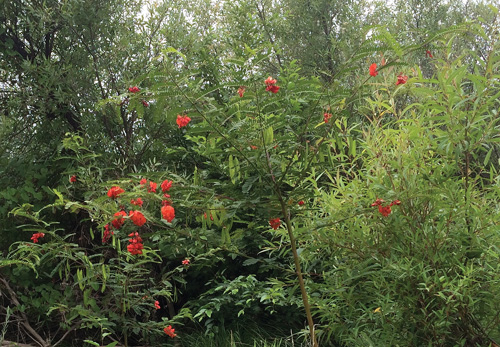It may look pretty, with its bright red and orange blossoms adding pops of color to its green foliage. But Scarlet Wisteria is also extremely aggressive, choking out native plants and taking over habitat in its path. And after years of watching out for the plant, Russian Riverkeeper Executive Director Don McEnhill said it’s now been identified along the river in Healdsburg.
In mid-July, 14 Scarlet Wisteria plants, mostly 2-4 years old, were found by the Russian Riverkeeper on the main stem of the riverbank, just below the confluence with Dry Creek.
A few days later the Russian Riverkeeper found two dozen large, mature seed-producing trees on a paddle down lower Dry Creek, and a dozen small plants along the river. The group stripped one mature tree of almost 1000 seedpods.
McEnhill said that this is the first time the plant has been seen on the main stem of the river in the past 15 years.
Scarlet Wisteria comes with many dangers; the plant consumes huge amounts of water, its shallow root systems increase erosion, it creates dense thickets, displaces native vegetation and is toxic and potentially lethal to humans and wildlife if ingested.
McEnhill said that the infestation seemed to originate from Dry Creek, and that he found three large plants downstream of Westside Road.
Scarlet Wisteria has large clusters of red blooms (it is the only shrub/tree on the river with red bloom), acacia like leaves, flat oblong seed pods, and it grows to a height of 12 to 14 feet. The seedpods can grow up to 3 to 4 inches long. When shaken in the wind, these pods make a rattling sound giving it the name “rattlebox.”
“We’ve lost over 90 percent of the historic plant community on the river. There is so little habitat that even having this stuff take over 100 acres would be a huge problem for wildlife,” McEnhill said. “All we need is two or three more plants and we’ll start losing a lot of species along the river.”
Scarlet Wisteria was discovered in 1999 along the American River Parkway in Sacramento, and has since spread throughout the Central Valley. Its ability to spread rapidly has earned it a Red Alert from The California Invasive Plant Council and the wisteria has the highest priority for removal along rivers in the Central Valley.
Russian Riverkeeper is currently developing a plan to attack the fast-growing invader before it gets well established in the Russian River. The first initiative is to map the current plants on the river and Dry Creek, while seeking permits from the Department of Fish and Wildlife and North Coast Waterboard to remove the wisteria.
McEnhill said that if the problem is ignored, Scarlet Wisteria will be almost impossible to destroy, and it will take about five years of follow-up to ensure the wisteria is completely eradicated.
“This is one plant we can actually get ahead of,” McEnhill said. “We can save our watershed a couple million dollars over the next 20 years by getting rid of it.”
Those who spot Red Wisteria are urged to contact Russian Riverkeeper with the plant’s location and, if possible, send pictures. Call or e-mail Felicia Herron, Restoration Coordinator at 707-433-1958 or e-mail at
Fe*****@ru****************.org
.
51.9
F
Healdsburg
November 25, 2024








